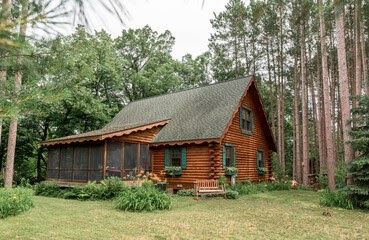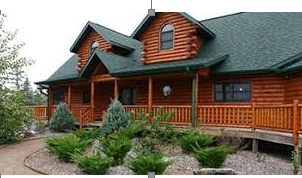The Best Ways to Care for Your Log Home Siding and Paneling

You’ve put a lot of time and effort into creating your dream log home but the job is not yet finished for the long term. By caring for the exterior and interior, you can maintain its beauty and charm for decades. A few small efforts can make a major difference when preserving and maintaining your log home siding and paneling.
There are several excellent products in the market that make caring for your home easier. You can care for a log home yourself or hire it. Consider doing the simple work yourself like cleaning and applying wood protection products. Let a professional take care of any wood areas you can’t safely access or any damage caused by moisture or insects. Keeping your log-sided home in tip-top shape also preserves its original color and warmth.
Keep the Exterior Log Siding Looking Great

- Keep the bottom row of log siding off the ground to prevent moisture entrance.
- Slope the soil down and away from the foundation to also prevent moisture issues.
- Build oversize eaves to keep more sun and moisture exposure off the siding.
- Cover gutters to prevent leaves and debris accumulation that traps wood-damaging water and can cause water leaking.
- From the start, apply pigmented stains and protective products with ultraviolet (UV) combatants for added protection.
Every spring and fall conduct a walk-around inspection of your home’s exterior siding and log trim. Spray the wood with a garden hose and notice if the water beads up or any dark wet spots appear. The dark spots mean water is soaking into the wood and they need some preservative added.
Be sure to carefully check the log ends because they can absorb up to five times more moisture than the siding. When stained, sealed, and cared for properly over the years. You can prevent moisture, insects, mildew, mold, and sun damage to your charming log home.
|
“By caring for the exterior and interior, you can maintain its beauty and charm for decades. A few small efforts can make a major difference when preserving and maintaining your log home siding and paneling.” |
Interior Pine or Cedar Log Siding Needs Less Care
Most log homeowners who build with log siding use the same material or wood paneling on the interior walls. The good news about interior log siding is that it requires much less maintenance than its exterior counterpart.
All you need is a mild cleaner for dust and dirt and oil to make it shine. Take these steps to keep it fresh:
- First, wipe the walls with a dust cloth or the brush attachment on a vacuum cleaner.
- Mix ½ cup of dishwashing liquid and 1 gallon of water thoroughly. Use a clean cloth or sponge to soak up some solution, wring it out, and wipe down the walls.
- While cleaning the walls, rinse the cloth or sponge frequently to get out dirt and dust.
- Let walls dry, and wash again with a solution of ½ cup of white vinegar mixed with 1 gallon of clean water. The vinegar will remove the soap residue.
- Use a few drops of mineral oil on a clean dry rag and buff the walls in a circular motion.
- Wow - the walls are clean, dry, and shiny and now you’re done!
Knotty Pine or Cedar Paneling Is Easy to Maintain

You may want to use a household oil soap as an all-in-one cleanser and sheen restorer.
Additional Tips to Consider
After you understand the basics of log siding and paneling care, there are some steps you should take to protect the walls and floors, including:
- Dust all horizontal wood surfaces before vacuuming to reduce dust accumulation on the floors after vacuuming.
- Don’t put furniture, lamps, bookcases, and other furnishings against the walls
- Consider installing chair railing in the dining area to protect wood walls from damage.
- Wash the walls with a little extra care in the kitchen if necessary where cooking oil and grease may splatter.
- Use furniture pads on legs and feet to protect the wood flooring.
- Use doormats at all entry doors.
Use only high-quality wood stains, preservative materials, and cleaners on siding for best results.
 Store Location
Store Location







